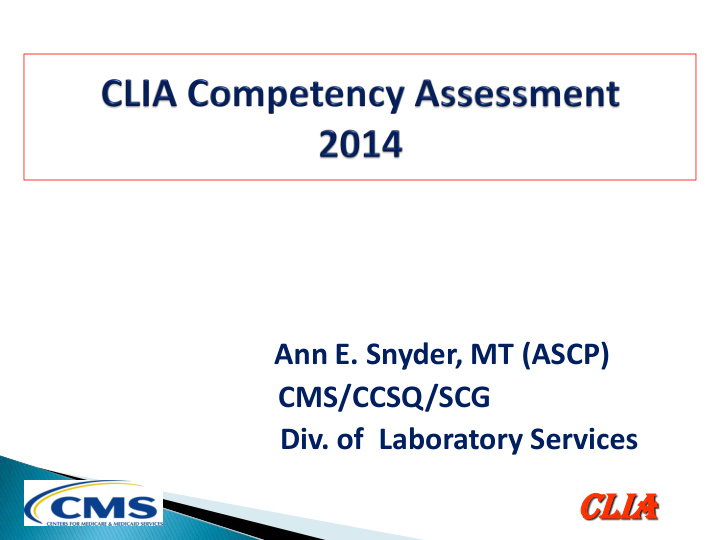



Ann E. Snyder, MT (ASCP) CMS/CCSQ/SCG Div. of Laboratory Services CLIA
Discuss the CLIA regulations related to competency assessment Describe the 6 competency assessment requirements Provide some tips for meeting competency assessment and answer some frequently asked questions CLIA
• Definition & Introduction • Regulations • Rationale • Competency Assessment Policies • Tips • Frequently Asked Questions • Where to Obtain Information CLIA
Competency is the ability of laboratory personnel to apply their skill, knowledge, & experience to perform their duties correctly. . CLIA
Competency assessment is used to ensure that laboratory personnel are fulfilling their duties, as required by Federal regulations. CLIA
493.1413(b)(8) & 1451(b)(8) Technical Consultant/Supervisor • Evaluating the competency of all testing personnel & assuring that the staff maintain their competency to perform test procedures & report test results promptly, accurately, & proficiently • Includes 6 required procedures CLIA
493.1413(b)(9) & 1451(b)(9) Technical Consultant/Supervisor Evaluating and document competency • Semiannually the first year • Annually thereafter • Reevaluated with new test methodology or instrumentation CLIA
Individual conducting competency assessments must be qualified as TC or TS/GS CLIA
Competency assessment must be done for Provider-Performed Microscopy (PPM) individuals. CLIA
Competency assessment must be done for Provider-Performed Microscopy (PPM) individuals CLIA
Confirms training effectiveness Helps to ensure performance of test procedures remains consistent Part of overall quality management system CLIA
Studies indicate that more education and training produce higher quality results Survey experience indicates problems caused by human errors can have patient impact Routine CA can help prevent errors CLIA
Documented competency is required for all technical, supervisory & testing personnel Six procedures are necessary for all who perform non-waived testing for all tests performed CA must be documented CLIA
Must demonstrate competency based on regulatory responsibilities Checked on survey 1 MD practice o 6 procedures not required o Must show competency (e.g., peer review, PT) CLIA
(#1) Direct observation of routine patient test performance, including patient preparation, if applicable, specimen handling, processing & testing. CLIA
(#2) Monitoring the recording & reporting of test results CLIA
(#3) Review of intermediate test results or worksheets, QC records, PT results, & preventive maintenance records CLIA
(#4) Direct observation of performance of instrument maintenance & function checks CLIA
(#5) Assessment of test performance through testing previously analyzed specimens, internal blind testing samples, or external PT samples CLIA
(#6) Assessment of problem solving skills CLIA
Competency is not PT…but it is a good tool Pathologists should be evaluated by the laboratory director as technical supervisors Competency is NOT the same as performance evaluation or training Pictures/double-headed scopes work well for PPM testing CLIA
Check job duties to ensure CA covers all testing, reporting, PM, calibration, etc. When observing test performance, use the SOP, package insert (PI) to ensure procedure is current and being performed correctly It is important to document who performs the CA as well as when it was performed – surveyors will ask for this information . CLIA
Can use competency assessment for QA when confirming tests result printouts match reported/charted results Personnel performing waived tests, pre & post analytic activities & not in regulatory positions are not subject to competency, but it’s good QA Break Microbiology down into component parts CLIA
Follow up on QC corrective actions will demonstrate problem-solving ability Don’t have to do CA all at one time Build CA into existing quality practices, procedures (Quality System) Can often combine analytes tested on the same platform CLIA
If lab has a service contract for PM, it’s ok to review maintenance records If test methods are added or changed, competency must be re-evaluated prior to reporting test results Sole practitioners performing their own testing must show they are competent CLIA
Is it acceptable under CLIA for nurse manager to perform CA for POCT testing personnel? Yes, as long as the nurse manager meets the regulatory requirements to qualify as a TC + delegated in writing CLIA
Do the CA requirements differ for high and moderate complexity testing? No, the six required procedures are the same for all non-waived testing. CLIA
May I use training and personnel evaluations to assess competency? No, training/personnel evaluations are not the same as competency testing. CLIA
Who is responsible for performing the competency assessment? The TC is responsible for moderate complexity testing; the TS/GS is responsible for high complexity testing. CLIA
CMS/CLIA Web site: www.cms.hhs.gov/clia/ Interpretive Guidelines, Brochures #10 CMS CLIA Central Office : 410-786-3531 email: ann.snyder@cms.hhs.gov CLIA
Thank You Questions? CLIA
Recommend
More recommend